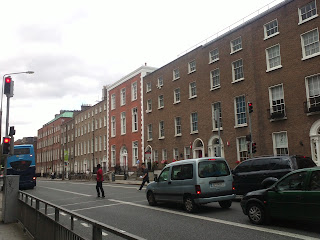At least breakfast is included in the price, and it's a big one too - sausages, baked beans, bacon, fried potatoes, eggs, tomatoes, mushrooms, black pudding, white pudding, porridge, toast, cereal, stewed fruit, pastries and yoghurt. I'm not fussed on big breakfasts and even though I'm in Ireland I can't bring myself to try the black pudding, because I know what it is made of. The breakfast room is decorated in what I would call "1950s granny style"... lace curtains and faded floral wallpaper, outdated prints on the walls, worn patterned carpet.
I manage to make my way on the bus without any mishaps to the University College Dublin. I'm here to visit CVERA, the government appointed agricultural research unit with the mandate of providing scientific evidence for advising government on policy, especially to do with TB control. It's a small and tightly run team, led by Australian Simon More, and despite the small size they seem to publish more in the scientific literature than any other country on the topic of bovine TB. I feel instantly at home; these people are all friendly, unassuming, quiet and kind. I am impressed by the level of detail recorded on stock in Ireland. At any time, the government knows the location and individual details of every farm animal in Ireland, and they have data going back for more than fifteen years. From this, incredibly detailed reports can be produced on cattle numbers and movements, and changes in the farming industry.
I also learn all about badger setts and what happens when a TB breakdown is detected. Badger culling is much less controversial here than it is in England, because as it's explained to me, hardly anyone in Ireland is more than one generation removed from farming and they are much more pragmatic about such things. I have a really interesting and varied conversation with Guy McGrath who is a GIS specialist. Apparently badger baiting is a popular but illegal sport in Ireland. Men in balaclavas turn up at night to badger setts with dogs and spades. They dig out the badgers and knock their canine teeth out, and set dogs on them in fighting rings. I imagine a lot of betting goes on in these underground rings. The thought makes me cringe.
I have a very worthwhile conversation with Simon More. He is a kind and genuine man and despite his unassuming manner he is one of the world's leading authorities on bovine TB. I show him my research results and he affirms my findings. New Zealand has a few things to learn from how they do things here. For a start, we have only just introduced a mandatory cattle identification scheme. It's going to make a big difference to our programme to be able to understand and monitor cattle movements.
Later in the afternoon, I meet up with Margaret Good. She is a warm and kind but no-nonsense Irish lady, with a huge wealth of experience in TB management, dating back to the 1980s. I enjoy discussing the differences in our two countries' programmes with her, and learning from what happens in Ireland.
Margaret drops me off at the guesthouse, where I pick up my bags and head off to meet Clayton, Chris's cousin, at Baggot St Bridge. Margaret had told me to walk west along the canal to the next bridge, and it's only after I've been waiting for Clayton for 40 minutes that I begin to realise I could well be at the wrong bridge and should have walked east instead. I have my heavy bag to tow for two more bridges, but I manage it by telling myself under my breath, "keep on going, you can do it", in the rhythm of my footsteps. Poor Clayton has had to wait for me and he has no idea where I am or how to contact me. But he's very good natured about it, and we walk through Merrion Square and he shows me the bronze memorial chair made for the actor who played Father Ted. Further along there's a very lifelike coloured stone sculpture of Oscar Wilde lolling on a rock. Apparently he lived very near here.
We catch the dart train towards the north of Dublin, chatting about the family on the way. It's nice to catch up with Clayton; he comes from good stock and he has inherited Grandad Davies' striking light blue eyes, which he's also passed on to his two beautiful little girls, Jorgia and Casey.
It's nice to stay with Clayton and D. They make me feel like part of the family and it brings back memories of when we had little children in the house. Jorgia is very chatty and shows me her dolls and toys, and where everyone lives on a world map on the wall. She's a great little girl.
In the morning, Clayton and the girls take me for a tour of the big park near their home. The park was donated to the city by the Guinness family. They had a huge house here until it burnt down in 1943. The red brick stables are still standing, and are used as an arts centre. Today there is a small market there.
It's nice to be in the park; it reminds me of New Zealand, but now all I really want is to go home.

























